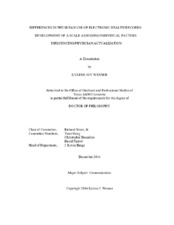| dc.contributor.advisor | Street, Jr., Richard | |
| dc.creator | Wesner, Kylene J | |
| dc.date.accessioned | 2015-04-28T15:30:41Z | |
| dc.date.available | 2016-12-01T06:36:16Z | |
| dc.date.created | 2014-12 | |
| dc.date.issued | 2014-10-30 | |
| dc.date.submitted | December 2014 | |
| dc.identifier.uri | https://hdl.handle.net/1969.1/153927 | |
| dc.description.abstract | Electronic health records (EHRs) are one of the most talked about topics within and surrounding health care organizations and the health care system in the United States; however, the U.S. has been slow to implement these computerized medical record systems into their organizations. One of the factors often overlooked regarding the implementation of EHRs, is the role of individual health care professionals and the effects produced by their interactions with the EHR as they perform their job duties throughout the day. Using a Theory of Organization-EHR Affordance Actualization as a guiding framework, the focus of this dissertation is to examine the factors that influence how physicians use the EHR at the individual-level during clinical interactions by analyzing physician perceptions of their interaction with the EHR while providing patient care in the exam room and how it influences their work process. A mixed methods approach was used to identify the affordances, EHR features, factors that influence EHR use, and individual physician characteristics that produce the visible effects of EHR use during the clinical encounter when individual physicians interact with the EHR.
The findings of this study confirm the identification of individual level affordances proposed by Strong and colleagues and propose three additional affordances. This study also identified additional features that should be taken into consideration when investigating individual level affordance actualization. Finally, this study provides a survey tool for practice managers, health care executives, trainers, and vendors to use in order to better understand the individual user characteristics of their physicians, predict their patterns of use based on these user characteristics, and thus tailor their training to enhance affordance actualization and organizational goal attainment. | en |
| dc.format.mimetype | application/pdf | |
| dc.language.iso | en | |
| dc.subject | EHR | en |
| dc.subject | affordance | en |
| dc.subject | actualization | en |
| dc.subject | communication and technology | en |
| dc.subject | technology integration in organizations | en |
| dc.title | Differences in Physician Use of Electronic Health Records: Development of a Scale Assessing Individual Factors Influencing Physician Actualization | en |
| dc.type | Thesis | en |
| thesis.degree.department | Communication | en |
| thesis.degree.discipline | Communication | en |
| thesis.degree.grantor | Texas A & M University | en |
| thesis.degree.name | Doctor of Philosophy | en |
| thesis.degree.level | Doctoral | en |
| dc.contributor.committeeMember | Hong, Traci | |
| dc.contributor.committeeMember | Beaudoin, Christopher | |
| dc.contributor.committeeMember | Parrott, David | |
| dc.type.material | text | en |
| dc.date.updated | 2015-04-28T15:30:42Z | |
| local.embargo.terms | 2016-12-01 | |
| local.etdauthor.orcid | 0000-0003-4535-477X | |


